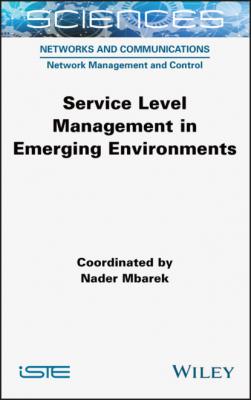ТОП просматриваемых книг сайта:
Service Level Management in Emerging Environments. Nader Mbarek
Читать онлайн.Название Service Level Management in Emerging Environments
Год выпуска 0
isbn 9781119818328
Автор произведения Nader Mbarek
Жанр Отраслевые издания
Издательство John Wiley & Sons Limited
The common value for the BO and SO is set to 2 as at least one real-time QoS class exists in all the scenarios considered. The packet size used in the different simulation scenarios is 50 bytes with a generation interval of 0.25 sec. The duration of each simulation is 100 sec, with a star topology based on a coordinator, namely the QBAIoT gateway.
1.6.3.2. Results
The first simulation scenario corresponds to an IoT service based on 3 RTMC objects. This results in an allocation of the 16 slots to the three objects. The second scenario corresponds to IoT services that require three RTMC objects and three RTNMC objects. Consequently, nine slots are allocated to RTMC objects and seven to RTNMC objects. The third scenario corresponds to nine objects (three RTMC, three RTNMC and three Streaming) resulting in a 7/6/3 type configuration of the slots. The last scenario corresponds to the existence of 12 objects (three of each QoS class). This results in a 6/5/3/2 type configuration of the slots.
The results illustrated in Figures 1.7 and 1.8 show that QBAIoT offers better average delays than the IEEE 802.15.4 standard to the QoS classes that are sensitive to this parameter, i.e. to the RTMC and RTNMC classes. It must be noted that the delays for packets with QBAIoT (when a unique QoS class exists in the gateway environments) is slightly greater than the standard, but respects the requirements of RTMC traffic. This difference is due to the test carried out on the slots to verify that they belong to the QoS CAP, which is not necessary for the standard traditional approach without QoS.
Figure 1.7. Average real-time mission critical delays for different scenarios
Figure 1.8. Average real-time non-mission critical delays for different scenarios
Figure 1.9 shows that QBAIoT offers better packet delivery ratios for all simulation scenarios and for all QoS classes. Indeed, by limiting the number of objects that can access the channel during a QoS CAP, there are fewer collisions and more packets are successfully transmitted to the destination.
Figure 1.9. Packet Delivery Ratio for all QoS classe. For a color version of this figure, see www.iste.co.uk/mbarek/service.zip
1.7. Conclusion
Developments in the domain of the IoT try to optimize the services provided while guaranteeing QoS and security. In this context, research studies and projects and also the various IoT organizations highlight the importance of guaranteeing a service level (QoS and security) between IoT service providers and customers. Different infrastructure, networks and providers interact to offer the IoT service. Thus, research aimed at guaranteeing service levels must take into account the different characteristics of these subenvironments in order to set up mechanisms that are adapted to them in terms of security and QoS.
Security and privacy are essential in the IoT to gain the trust of users and improve the use of services. IoT services impact different areas of daily life and, as a result, the IoT impacts the privacy of users. It is, therefore, essential to comply with European and international regulations concerning privacy protection and this must be integrated into the services offered in an IoT environment. On the other hand, the QoS is another important component of service level that must be considered when offering IoT services. These services can belong to critical fields such as e-health or security. The prioritizing of flows and differentiation of processing are necessary to comply with the requirements and characteristics of these flows corresponding to various fields and services. Several projects have been carried out to set up QoS in the IoT service offering, but there are several challenges that must still be overcome in order to meet the requirements of the IoT environment. In this context, QBAIoT, an approach to guarantee QoS at the device layer of the IoT architecture, makes it possible to differentiate traffic to meet the requirements of each IoT application. This access method based on the IEEE 802.15.4 standard takes into account four categories of service and makes it possible to obtain good performance with a QoS guarantee.
1.8. References
Abdemeziem, M.R. (2016). Data confidentiality in the Internet of Things. PhD Thesis, University of Lorraine, Metz.
AIOTI. (2017). Report on workshop on security and privacy in the hyper connected world. Report, AIOTI.
Alcatel Lucent Enterprise. (2018). The Internet of Things in transportation [Online]. Available at: https://www.al-enterprise.com/-/media/assets/internet/documents/iot-for-transportation-solutionbrief-en.pdf [Accessed 6 March 2020].
Allerin. (2018). Authentication and device identification in IoT security [Online]. Available at: https://www.allerin.com/blog/authentication-and-device-identification-in-iot-security [Accessed 7 November 2018].
ARMOUR. (2016). ARMOUR Experiments and Requirements [Online]. Available at: https://www.armour-project.eu/wp-content/uploads/2016/08/D11-ARMOUR-Experiments-and-Requirements.pdf.
ARMOUR. (2018). Consortium [Online]. Available at: https://www.armour-project.eu/consortium/ [Accessed 2 November 2018].
Babiarz, J., Chan, K., and Baker, F. (2006). Configuration guidelines for DiffServ Service classes [Online]. Memo, IETF, 4594. Available at: https://tools.ietf.org/html/rfc4594.
Balte, A., Kashid, A., and Patil, B. (2015). Security issues in Internet of Things (IoT): A survey. International Journal of Advanced Research in Computer Science and Software Engineering, 5(4), 450–455.
Bhaddurgatte, R.C. and Kumar, V. (2015). Review: QoS architecture and implementations in IoT environment. Research & Reviews: Journal of Engineering and Technology, S1, 6–12.
Braden, R., Clark, D., and Shenker, S. (1994). Integrated services in the Internet architecture: An overview [Online]. Memo, IETF, 1633. Available at: https://tools.ietf.org/html/rfc1633.
Cantora. (2013). Mirror of AVR-Crypto-Lib. GitHub.
Chowdhury, A., Mukherjee, S., and Souray Banerjee, S. (2018). Examining of QoS in Cloud Computing

